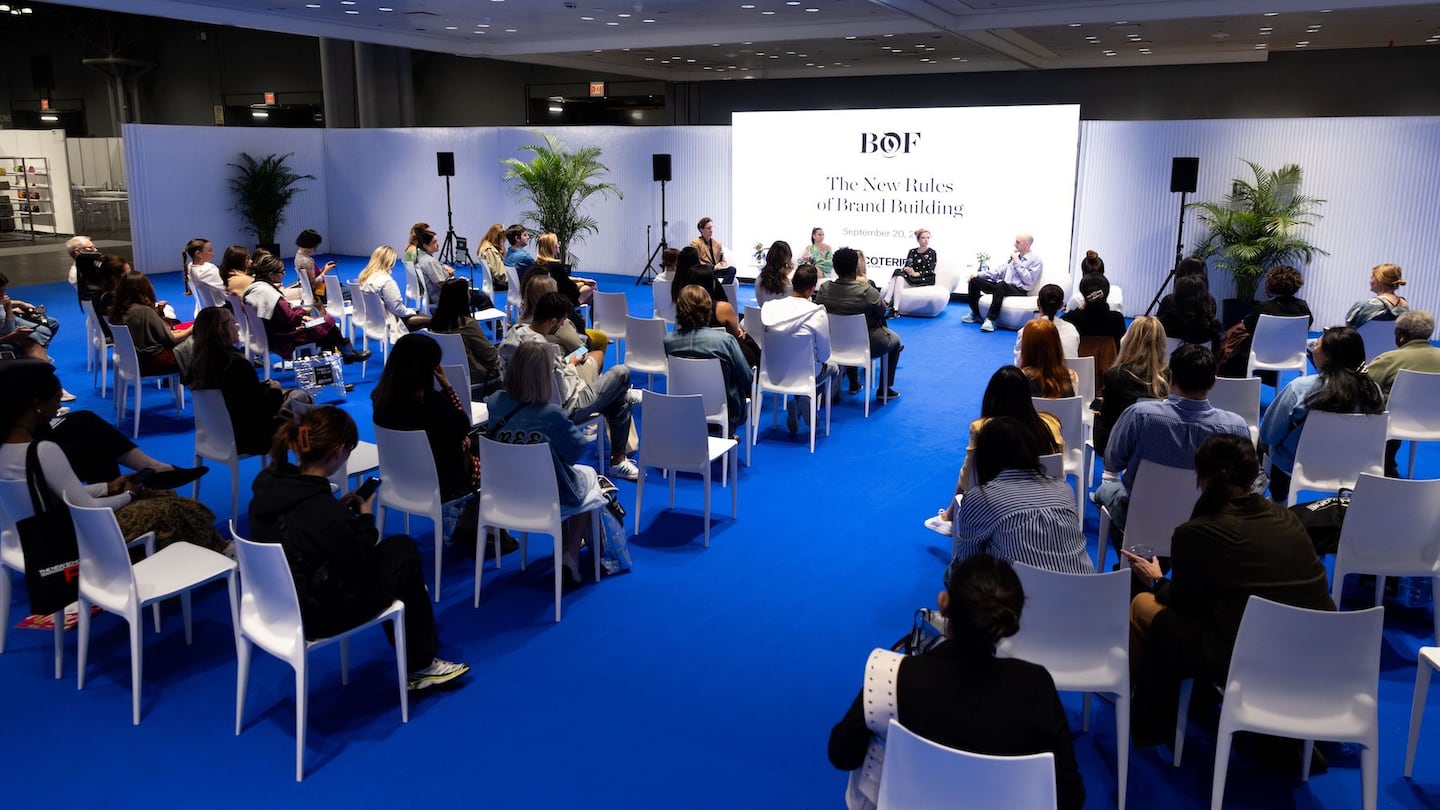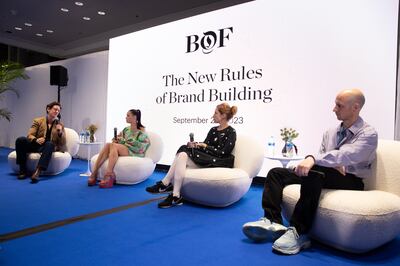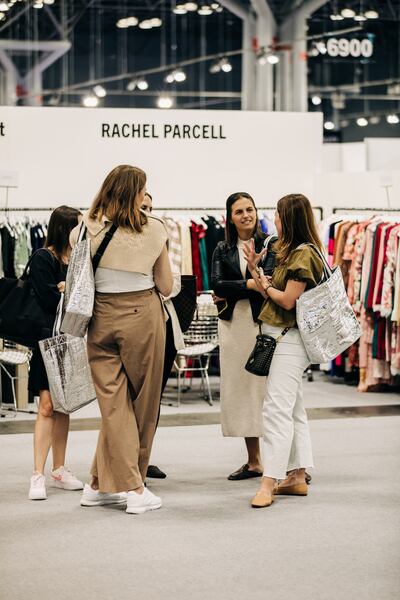
The Business of Fashion
Agenda-setting intelligence, analysis and advice for the global fashion community.

Agenda-setting intelligence, analysis and advice for the global fashion community.

Today, to successfully build a brand and engage Millennial and Gen-Z consumers, brands must navigate shifting wholesale market dynamics, master complex and evolving digital channels and authentically communicate their values and purpose as much as their aesthetic identity and product provenance.
Last week, on the Coterie New York’s show floor, BoF interviewed three leading SME designer-entrepreneurs, Christian Juul Nielsen, the founder of Akanvas, Batsheva Hay of Batsheva and Arianne Elmy of Arianne Elmy, to hear how they built their businesses and reimagined their creative and sales practices to reflect evolving consumer sentiment and behaviour.

Each of the panelists exhibited and showcased their brand’s collections in Coterie New York’s Gallery space — which featured ten New York-based brands that represented distinctive strategies and unique points of difference.
Indeed, returning to New York’s Javits Center, Informa Markets Fashion’s Coterie New York’s show, welcomed more than 1,040 exhibiting brands this September to its Spring/Summer 24 edition, with an increasingly global roster of brands. International participation was up 27 percent year-over-year to more than 400 brands, including businesses from South Korea, Brazil, Greece, Italy, Turkey and France.

Below, BoF shares key insights from the discussion, from connecting with consumers in a transformed social media landscape, to establishing and supporting inclusive communities and approaching wholesale strategically.
Utilise Your Wholesale Partners as Strategic Collaborators
BH: As far as wholesale, the specialty boutiques and small places are really undervalued. I think you want to be in the big retailers because they have more clout, and it does get your name out. Since you do have a tangible product that people want to try on, you want to get to that person who’s wandering around in Minneapolis, looking for something to wear to a wedding. They should wander into a store and see your dress there and try it on. So I do think it’s really important to be everywhere — physically, and in terms of media — as much as you possibly can.
The feedback you get — especially when it’s a big retailer — particularly their sell-through reports are key. This is how you can figure out what their top sellers are. Sometimes it’s the same as what’s selling on my website, and I can see “This is a winner — this is a bestseller — keep making it”. Sometimes it’s different and you have to ask, “Who’s their customer? Why is she different from mine? Maybe I need to be selling this differently.” The more information you get, the more feedback you get, whether it’s around the cut, the fit, surprising big sellers — that’s valuable insight.
AE: Everyone we partner with we want them to benefit in the same way we’re benefitting from them. We send our customers to our wholesale boutiques because our customers often DM us and ask where they can try our dresses on. It’s great if we can select the piece and say, “It’s a bestseller, you can go and try it on there.”
The more information you get, the more feedback you get, whether it’s around the cut, the fit, surprising big sellers — that’s valuable insight.
We’ve also partnered with Shopbop. They have gone above and beyond for us and been such an amazing partner. They’ve sent us traffic and we’ve sent them traffic. It’s beneficial to each business. Key stockists have also just been amazing — putting us in their photoshoots, helping us with design. I’ll share images of things that we’re working on, they’ll tell me if they want to pick it up. We find that our partners are keen to experiment with us and they reorder our stuff every few months.
CJN: With large stockists, I strongly recommend — to everyone with a brand — to go and meet them in stores. I go as much as I possibly can. We have two locations in New York that I go to at least once per season. I then go over the weekend myself just to engage with the store associates, find out what they like, what they’re selling more than anything.
Next month, we’re going on a little tour with my sales agent — we’re going down to Houston to some of the department stores there. I share my creative background and how I translate that into my collection. Then it becomes communications — being able to discuss and share what the brand is.
Navigate a Transformed Social Media Advertising Landscape
AE: We use Facebook and Instagram for ads. I have used Pinterest and TikTok — I haven’t found the return on investment as good. And because I am running all my ads, it’s just overwhelming for me to do those channels too. We do use Google shopping, but I kind of just keep that running in the background, for when people search for the brand.
I’ve never hired an agency. I have found that I try everything first myself. If it doesn’t work out, then I hire someone. The problem is someone’s just going to tell you exactly what they think you need versus what you actually need. So you need to be the expert first before hiring someone else. I just started really playing around. I had a really small budget. I had to borrow some money and had to make it work. And then next thing you know, I’m seeing the return on investment. So, I’m reinvesting that, I’m putting that back every day and then just really playing around and not getting discouraged because I think a lot of people get discouraged with the ads.
Another thing is that you do have to spend money to make money. You need to spend over $100 a day. The ads need to learn, and you need to put money in there for them to learn. You need to test, and you need to let something run for at least a week before you know if it worked. There is a learning phase, but then once you kind of crack that code for your business, the payoff is amazing.
CJN: Your Instagram account needs to become shoppable and you then connect that to Facebook advertising — because it’s Meta. You can pay between $5 and $5,000 and you just select what are your categories and what platforms do you want it to go out on. It’s difficult to say what is the percentage of your money you should spend on it. Say you spend $800 to start with. You then need to ask — ‘what did I get for $800?’
But really, if you’re starting your brand on your own, then I would do the research and just start little by little. For all the major social media platform advertisements, the system is made in such a way that you just need to watch the YouTube videos on how to do it. I’m not saying it’s easy, but you can look on YouTube to determine how to do a Facebook ad.
BH: That social media entry point really did create the business and still does. I always knew that the photos that I made mostly with my husband were important to the brand image as a whole. But then a wholesale business grew, and, at the same time, Instagram had its shopping functionality, and that became a whole way of dropping something and having people clicking through to buy.
I’m not a sharing person and I’m having trouble dealing with the idea of TikTok now because I feel like we just dealt with Instagram. With TikTok I’m really trying — it makes me feel like I’m 90 years-old. I may as well be on Facebook trying to sell things. But I do feel that it’s important. Instagram does feel over-saturated and you’re spending more for less. So, as a brand we have decided to focus on TikTok.
With large stockists, I strongly recommend — to everyone with a brand — to go and meet them in stores. I go as much as I possibly can.
It’s sad to say, but even with the press, my community only sees things when I post them on Instagram, which is sad to see because you realise how the print magazine has died to the point that people don’t see it. And then I post it on Instagram and they’re like, I love that.
Optimise Event Activations and Engage Influencers
CJN: I think it’s important to do other kinds of activations and not put all the energy into your story and your posting and who’s wearing it with a lot of followers and everything.
The main focus of this is not just to have X amount of people seeing the story or X amount of people following us. I have a friend who has a gallery in Southampton and he sells furniture and glassware and we decided to do a pop up together, in July. We drove out there with all the stock we had that felt relevant and we made a pop-up store for Akanvas in the middle of his gallery.
The point was really to meet people out there in the Hamptons that love fashion — really going and just meeting people. But it is important, especially as a new brand, to identify who your ambassadors are and be available to support. If they’re going home for a family birthday and they want a good look, it may not be a big brand moment, but it can pay off.
What I really do a lot of is communicating and connecting with people I deem influencers when I’m not doing a show or when it’s not Fashion Week or when it’s not a party. I’m working to become a brand where, if they have a small event, creators know, “Ok I can always DM Christian and come by and get a dress. For me, it’s been mutually beneficial— they all show up at my show, dressed in Akanvas and everyone’s posting. Building these relationships is key.
Prioritise Purpose-Driven Considerations
AE — As a female business owner — you witness how hard it is for women. And it’s really important for me as a brand to have something I stand for. I started delving deep into the statistics and learning just how bad it was and began speaking up, on Instagram, for women’s’ rights.
We have some customers that don’t appreciate it and will even return product because of what we say. Others appreciate it and buy more because of that. Improving women and where we are in the business world is critical. We hire all women, use female-owned and operated factories, and continue work to uplift women and push them forward.
CJN — I had this conversation with somebody in Copenhagen a couple of weeks ago who said, “we stopped saying sustainable, we started saying responsible.” If you build up your brand, just be as responsible as you can. If you have extra fabric, cut it up and use it up. Donate it to schools. Whatever you can do.
Where possible, I try to order recycled materials. We have a coat now on our website made from 75 percent recycled wool. The supplier gathers vintage garments, takes them apart, and reweaves them into new materials. These suppliers are out there, but it takes a little bit of research to find them. It’s difficult to get all your materials to be sustainable, because honestly it doesn’t really exist if you want colours, for instance. A lot of the sustainable fabrics, for example recycled wool, if you re-dye them it’s not really sustainable, so then you stay in the beige or navy or black tones. It’s a case of making better choices, where possible.
This is a sponsored feature paid for by Coterie New York as part of a BoF partnership.
Designer brands including Gucci and Anya Hindmarch have been left millions of pounds out of pocket and some customers will not get refunds after the online fashion site collapsed owing more than £210m last month.
Antitrust enforcers said Tapestry’s acquisition of Capri would raise prices on handbags and accessories in the affordable luxury sector, harming consumers.
As a push to maximise sales of its popular Samba model starts to weigh on its desirability, the German sportswear giant is betting on other retro sneaker styles to tap surging demand for the 1980s ‘Terrace’ look. But fashion cycles come and go, cautions Andrea Felsted.
The rental platform saw its stock soar last week after predicting it would hit a key profitability metric this year. A new marketing push and more robust inventory are the key to unlocking elusive growth, CEO Jenn Hyman tells BoF.